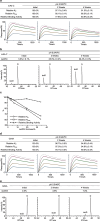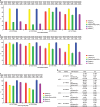Early determination of potential critical quality attributes of therapeutic antibodies in developability studies through surface plasmon resonance-based relative binding activity assessment
- PMID: 38956880
- PMCID: PMC11225922
- DOI: 10.1080/19420862.2024.2374607
Early determination of potential critical quality attributes of therapeutic antibodies in developability studies through surface plasmon resonance-based relative binding activity assessment
Abstract
Precise measurement of the binding activity changes of therapeutic antibodies is important to determine the potential critical quality attributes (CQAs) in developability assessment at the early stage of antibody development. Here, we report a surface plasmon resonance (SPR)-based relative binding activity method, which incorporates both binding affinity and binding response and allows us to determine relative binding activity of antibodies with high accuracy and precision. We applied the SPR-based relative binding activity method in multiple forced degradation studies of antibody developability assessment. The current developability assessment strategy provided comprehensive, precise characterization of antibody binding activity in the stability studies, enabling us to perform correlation analysis and establish the structure-function relationship between relative binding activity and quality attributes. The impact of a given quality attribute on binding activity could be confidently determined without isolating antibody variants. We identified several potential CQAs, including Asp isomerization, Asn deamidation, and fragmentation. Some potential CQAs affected binding affinity of antibody and resulted in a reduction of binding activity. Certain potential CQAs impaired antibody binding to antigen and led to a loss of binding activity. A few potential CQAs could influence both binding affinity and binding response and cause a substantial decrease in antibody binding activity. Specifically, we identified low abundance Asn33 deamidation in the light chain complementarity-determining region as a potential CQA, in which all the stressed antibody samples showed Asn33 deamidation abundances ranging from 4.2% to 27.5% and a mild binding affinity change from 1.76 nM to 2.16 nM.
Keywords: Antibody development; critical quality attribute; developability assessment; forced degradation; relative binding activity; surface plasmon resonance; therapeutic antibody.
Conflict of interest statement
No potential conflict of interest was reported by the author(s).
Figures






Similar articles
-
A competitive binding-mass spectrometry strategy for high-throughput evaluation of potential critical quality attributes of therapeutic monoclonal antibodies.MAbs. 2022 Jan-Dec;14(1):2133674. doi: 10.1080/19420862.2022.2133674. MAbs. 2022. PMID: 36224723 Free PMC article.
-
Drug-like antibodies with high affinity, diversity and developability directly from next-generation antibody libraries.MAbs. 2021 Jan-Dec;13(1):1980942. doi: 10.1080/19420862.2021.1980942. MAbs. 2021. PMID: 34850665 Free PMC article.
-
Engineering an anti-CD52 antibody for enhanced deamidation stability.MAbs. 2019 Oct;11(7):1266-1275. doi: 10.1080/19420862.2019.1631117. Epub 2019 Jul 18. MAbs. 2019. PMID: 31199181 Free PMC article.
-
Using bispecific antibodies in forced degradation studies to analyze the structure-function relationships of symmetrically and asymmetrically modified antibodies.MAbs. 2019 Aug/Sep;11(6):1101-1112. doi: 10.1080/19420862.2019.1618675. Epub 2019 Jun 4. MAbs. 2019. PMID: 31161859 Free PMC article. Review.
-
Structure, heterogeneity and developability assessment of therapeutic antibodies.MAbs. 2019 Feb/Mar;11(2):239-264. doi: 10.1080/19420862.2018.1553476. Epub 2018 Dec 17. MAbs. 2019. PMID: 30543482 Free PMC article. Review.
References
-
- The Antibody Society. Therapeutic monoclonal antibodies approved or in regulatory review. [accessed 2024 June 24]. www.antibodysociety.org/antibody-therapeutics-product-data.
MeSH terms
Substances
LinkOut - more resources
Full Text Sources
